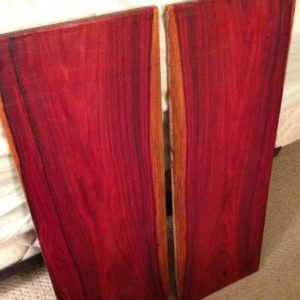Hello,
I build guitars as a hobby and I ran into the problem that I’m sure has been encountered before. I bought some top laminate material for a solid-body guitar, roughly 3/8″ thick, 7-1/2″ wide, and 2′ long. My jointer is only 6″ wide so it is not possible to run it on that. I would prefer not to go out and buy an 8″ jointer. I am aware of handplaning but I would like to find a solution with power tools first. Is there any way to set up a 13″ planer to act as a jointer for such thin material? I have also heard of thickness sanding it but I do not have a thickness sander. If i makes any difference the wood is Ziricote and Cocobolo.
Any tips or links to previous discussions are welcome.
Trevor
















Replies
Guitar
Are you asking for a tip on thickness planing wood ( on the flat) that's wider than your joiner ?
SA
jointer vs. thickness planer
I, too, am unclear on your objective, Trevor.
There are, I think, three operations that might apply here: 1) flattening (i.e. eliminating high spots on a gently-cupped board), 2) thickness planing (i.e. reducing the 3/8" thickness to something thinner), and 3) edge joining (i.e. truing the edges for making a wider panel).
Your existing jointer can handle #3 easily. A 13" thickness planer would handle #2 nicely, depending on the minimum thickness the particular model can handle. If the desired thickness is less than the minimum of the thickness planer, a simple "sled" can be made to carry the stock through the planer.
Flattening is, perhaps, the most problematic of the three operations, particularly with already-thin stock. Assuming a slightly-cupped board, one first needs to make sure there is sufficient thickness to yeild what you want after eliminating the high spots (the two edges on one face, and the center on the other face).
Using a thickness planer on its own doesn't work, since the feed rolers will flatten the board before it reaches the cutter knives. So, you end up with a thinner board that is still cupped.
Flattening on a wide jointer requires both skill and a properly tuned jointer. Otherwise, you might end up with a lengthwise taper to the board.
A more-complex sled can be used in conjunction with a thickness planer for flattening. The complexity of the sled amounts to supporting the edges and the center of the cupped board, so only the high spots are planed as the sled-supported board passes through the thickness planer. A fair amount of precision is required in the sled to accomplish the task, however, and cuts need to be very "light".
Considering all of this, you might be well-served to re-think the hand plane approach.
Check out: Woodworking #175 , pp. 58 January 1, 2005. I use it all of the time for wide boards.
mk
Yes but I can't help wondering why
From the start it was clear to me you want to face one side flat. To run one side on the jointer to make it flat so you can then thickness it or use it as a reference for working the other side.
To use power tools put the face that has some concavity down against your ( ? flat ? ) work bench.
Put strips of paper or card board under the hollow high spots to support it so you don't flex it downward while working the top side.
Work the top side with a power belt sander or other sander of your choice to take off the high spots so the upper most face is flat.
Use a straight edge and winding sticks to indicate where to take off material.
NOW
Let me say that when you perfect your planing skills on these exact two species of wood (practice on scrap of these same woods ! ! ! !) you will wonder what the big deal is. These are small surfaces and only a couple of them.
Power tools are for large quantities.
The Cocobolo smells like roses when you plane it. It is one of "THE ROSE WOODS". It is safer to make curls of this stuff than dust. These can be quite toxic woods for some people.
I can't help it so you may want to skip reading the next bit if you don't like smart ass comments :
you could run your dust collector backwards to fill the room with fairly toxic wood dust which is what these are, and put some chips of wood in a blender and turn it on to get all the noise of the jointer or planer and then while all this is going on just use the hand planes.
No really . . . just plane it. If you have problems we can help you over come them.
You will wonder why you ever wanted to run it on the jointer.
Nice photo by the way. Where is the ziricote ?
This forum post is now archived. Commenting has been disabled